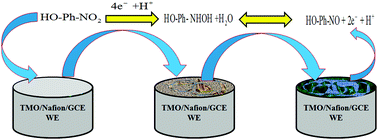Development of an ultra-sensitive para-nitrophenol sensor using tri-metallic oxide MoO2·Fe3O4·CuO nanocomposites†
Abstract
A tri-metal oxide, MoO2·Fe3O4·CuO (TMO), was synthesized by the co-precipitation method and characterized by XRD, SEM-EDS, and FTIR. The average particle size of the nanocomposite was found to be 34.85 nm. The zeta potential and hydrodynamic size of the MoO2·Fe3O4·CuO nanocomposite were studied in acidic and basic pH respectively. A glassy carbon electrode (GCE) was modified by MoO2·Fe3O4·CuO to develop a chemical sensor for para-nitrophenol (p-NP). A simple I–V method was employed for this study. Excellent sensitivity, an ultra-low detection limit, long-term stability, and reproducibility of the MoO2·Fe3O4·CuO/Nafion/GCE sensor were observed towards p-NP. A linear calibration plot (r2: 0.9995) was obtained for 1.0 pM to 0.01 mM aqueous p-NP solution, with a sensitivity value of 5.2430 μA μM−1 cm−2 and remarkably low detection limit (LOD) of 0.2 pM.



 Please wait while we load your content...
Please wait while we load your content...